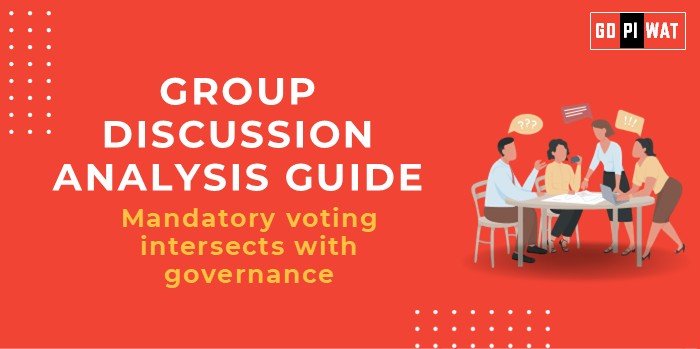📋 Group Discussion Analysis Guide
🗳️ Introduction to the Topic
Opening Context: Voting is the cornerstone of democracy, ensuring representation and accountability. Yet, voter turnout remains a concern, even in established democracies.
Topic Background: Mandatory voting, as implemented in countries like Australia and Belgium, ensures high voter participation but sparks debates about individual freedoms and the quality of democratic engagement.
📊 Quick Facts and Key Statistics
- Global Voter Turnout (2023): Averaged at 66% for national elections (Source: IDEA).
- Countries with Mandatory Voting: Over 20 nations, including Australia (compulsory since 1924) and Brazil.
- Penalty for Non-Compliance: Fines range from €3 (Belgium) to $80 (Australia).
- India’s Voter Turnout (2019): 67%, with urban areas trailing rural in participation.
🌍 Stakeholders and Their Roles
- Governments: Implementing voting policies and ensuring electoral infrastructure.
- Citizens: Participating in the democratic process and holding representatives accountable.
- Electoral Commissions: Managing elections, enforcing rules, and educating voters.
- Civil Society Organizations: Promoting awareness and voter turnout campaigns.
✨ Achievements and Challenges
✅ Achievements:
- Australia: Maintains a voter turnout above 90%.
- Brazil: Strong civic engagement despite political polarization.
- Encourages policy responsiveness to public needs.
⚠️ Challenges:
- Freedom vs Obligation: Critics argue mandatory voting undermines individual liberty.
- Voter Apathy: Forced participation may lead to uninformed or protest votes.
- Administrative Costs: Implementing penalties and monitoring compliance can strain resources.
🌐 Global Comparisons
- Belgium: High turnout but with increased blank votes.
- Sweden (Non-Compulsory): Achieves 80% turnout through strong civic culture.
📖 Case Study
In Gujarat, India, local-level mandatory voting laws (2010) faced implementation and compliance challenges.
📚 Structured Arguments for Discussion
- Supporting Stance: “Mandatory voting ensures inclusive representation and strengthens democracy.”
- Opposing Stance: “Forcing individuals to vote violates their right to abstain and undermines genuine democratic choice.”
- Balanced Perspective: “Mandatory voting can boost participation but must be accompanied by voter education to ensure meaningful engagement.”
📣 Effective Discussion Approaches
- Opening Approaches:
- Statistical: “Countries with mandatory voting consistently report turnouts above 90%.”
- Ethical: “Is it ethical to enforce democracy through compulsion?”
- Counter-Argument Handling:
- Acknowledge concerns (e.g., freedom) and suggest mitigations (e.g., education programs).
📈 Strategic Analysis of Strengths and Weaknesses
- Strengths: Increases legitimacy and participation; reduces influence of extreme ideologies.
- Weaknesses: Implementation costs; potential for uninformed voting.
- Opportunities: Enhanced civic education; stronger policy focus on voter needs.
- Threats: Public backlash; risk of non-serious voting behaviors.
🏫 Connecting with B-School Applications
- Real-World Applications: Understanding mandatory voting can link to leadership and governance modules.
- Sample Interview Questions:
- “How would mandatory voting impact democracy in India?”
- “Compare mandatory and voluntary voting systems.”
- Insights for Students: Study policy frameworks and voter behavior for projects on electoral reforms.


